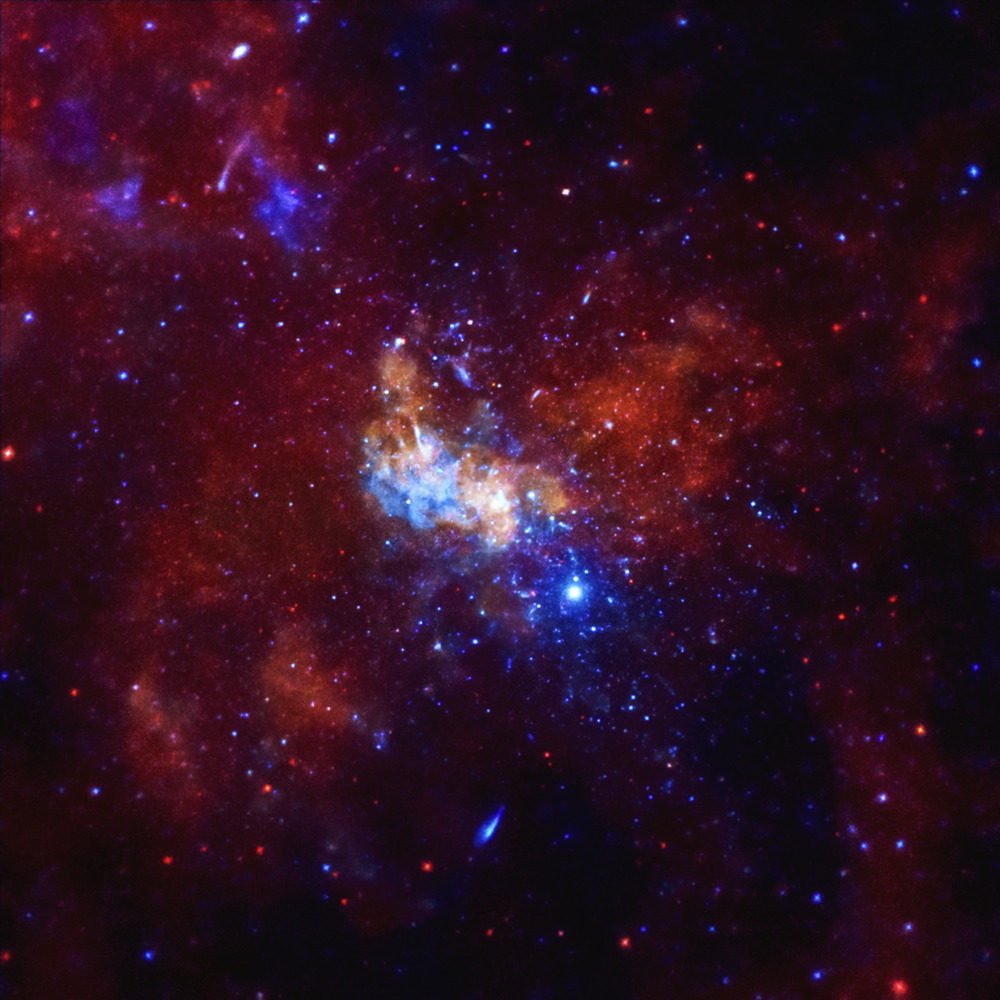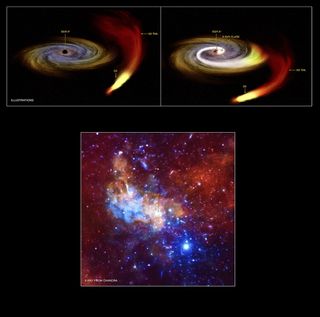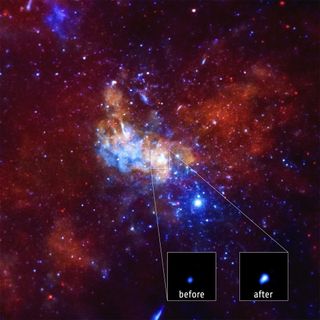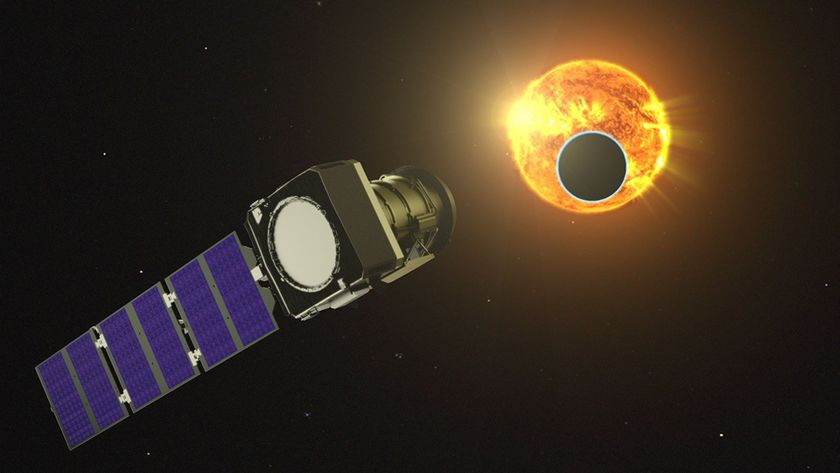Milky Way's Monster Black Hole Belches Big, But Why?

When the monster back hole at the center of the Milky Way galaxy belched out an exceptionally high number of powerful X-ray flares last year, it made astronomers wonder — is this a sign that the beast chowed down on a passing gas cloud, or is this lack of cosmic etiquette typical for black holes?
The black hole at the center of the Milky Way, known as Sagittarius A* (Sgr A* for short), is typically very quiet – it doesn't eat a lot of material, and there is relatively little light that radiates from the region around it. Which is why the apparent uptick in bright X-ray flares came as a surprise to scientists.
Could the bright flares seen in August 2014 have been caused by a gas cloud that passed too close to the black hole, and become an unsuspecting snack? And if that is the case, what does it tell scientists about what exactly happens to material that falls into a black hole? Alternatively, are these types of flare clusters typical of black holes, and an example of scientists' limited understanding of these mighty beasts? Upcoming observations may shed some light on these dark objects. [Images: Milky Way's Monster Black Hole Shreds … Something]
Bright flare activity increases
Packing a double punch of observational power, NASA's Chandra X-ray Observatory and the European Space Agency's XMM-Newton space telescope have been observing Sgr A* (pronounced "Sagittarius A-star") on and off since 1999. In the last three years, the total coverage time has increased thanks to a series of dedicated observation campaigns.
For long stretches, Chandra's detectors would see only "quiescent" X-ray activity from Sgr A*, and then, suddenly, a bright flare would appear. The center of the Milky Way is one of the most densely populated regions of the galaxy, and the view between Earth and Sgr A* is blocked by stars and gas clouds. The Chandra scientists cherished the light that managed to make its way to their detectors, according to Daryl Haggard, an astrophysicist at McGill University in Montreal, who studies the black hole using Chandra data.
Haggard is a co-author on a new study suggesting there was a two- to threefold increase in the number of bright flares emitted by Sgr A* beginning in August 2014 and extending through November 2014 (the paper does not show an overall increase in the flare rate). In one particularly active period, five bright X-ray flares burst forth from Sgr A* in a time frame that would typically see only one. One of the flares, seen in September, was three times brighter than any other flare detected from that region. The new paper looked at 15 years of Chandra and XMM-Newton data, as well as data from the SWIFT space telescope, in an effort to show that the increase was not merely a result of greater observation time.
What was happening to cause the increase? According to the new research, there are two leading ideas.
Get the Space.com Newsletter
Breaking space news, the latest updates on rocket launches, skywatching events and more!
G2, the mystery object
The first hypothesis involves a controversial object called G2. In 2011, a group of astronomers using the Very Large Telescope in Chile announced that this cosmic daredevil was going to make a very tight swing around Sgr A*. What would happen during this close approach was a subject of hot debate, because scientists couldn't say for sure what G2 was – a pure dust cloud or a compact object surrounded by a dust cloud.
If G2 is a solid object, then it should have swung around Sgr A* without being pulled past the event horizon, beyond which nothing, not even light, can escape. But if it is pure gas, scientists predicted that the gravity of the black hole would smear it like a wisp of smoke, and a sizable amount of material would become lunch for Sgr A*. That would, theoretically, produce an increase in the light emitted from the region around the black hole, because when material falls into a black hole it accelerates rapidly, causing it to radiate light.
That means that if G2 is a dust cloud, it could have provided scientists with the first real-time, short-term observation of a black hole eating. To watch one of the most monstrous cosmic creatures in the universe devour a meal right in our own backyard would be an unrivaled opportunity for scientists. It would tell them about how black holes grow over their lifetimes, and provide new insights into the strange physics that takes place near the edge of these extreme gravity wells. Imagine a scientist who is trying to study lions in the wild, but never getting to see them hunt and devour their prey — G2 might finally let scientists watch Sgr A* in action.
The excitement was a palpable lead-up to G2's close approach to Sgr A*. Andrea Ghez, an astrophysicist at the University of California at Los Angeles and one of the scientists who confirmed the existence of Sgr A*, said it was one of the "most watched events in astronomy in my career."
Chandra saw nothing, nor did any of the other telescopes observing at the time.
Stefan Gillessen, a researcher at the Max Planck Institute for Extraterrestrial Physics in Germany and one of the lead proponents of the gas cloud theory, argued that G2 might still be a pure gas cloud, but that the dynamics of how and when it would be pulled into Sgr A* were different than originally predicted. Scientists don't fully understand how material might behave around a black hole.
The new suggestion that Sgr A* released an increased number of bright flares in late 2014 could be the missing light show, according to Gabriel Ponti, a research fellow with the Max Planck group and the lead author on the new paper. Perhaps the material from G2 took longer than expected to fall toward the black hole and radiate.
"A year or so ago, we thought [G2] had absolutely no effect on Sgr A*, but our new data raise the possibility that that might not be the case," Ponti said in a statement from Chandra. [Black Holes of the Universe in Images]

A cluster of flares
Ponti cautions that the new research cannot confirm the connection between the flare activity and G2 — there's no evidence to show that it isn't just a coincidence. Plus, the paper points out that observations in infrared light seem to show that G2 has survived its trip around Sgr A*, suggesting it is not a pure gas cloud.
This doesn't rule out the possibility that some of the gas from G2 was pulled into the black hole, but it means scientists would have to have a new model for how much gas could be syphoned from G2. And that raises the question of how quickly material moves through the region around a black hole, and around Sgr A* in particular. Does it flow down to the black hole's gaping maw in a smooth, quickly moving stream, like cream moving through coffee? Or is it slow, like molasses across asphalt? If this burst of flare activity is due to G2 passing by, it would suggest that material falls very quickly, according to Haggard. In fact, it would suggest that material is basically in free- fall as it gets closer to the black hole's event horizon. [The Strangest Black Holes in Space]
The likelihood of a G2 connection to the increased flare activity "seems tenuous to me," Haggard told Space.com. She prefers an alternative possibility — that black holes normally exhibit "flare clustering," or bursts of activity that vary from the "average" behavior they exhibit most of the time.
Ponti writes in his blog post for the Chandra website that other black holes that accrete matter at a similar rate to Sgr A* (but which are millions of times less massive) also show "long-term modulation in their flaring properties." (Another factor to consider is that an object called G1, spotted before G2 and with a similar physical appearance, approached Sgr A* at a similar distance in 2001, but there was "no particular evidence for anything unusual happening as a result of G1's passage." However, he also notes that "the X-ray monitoring was much sparser" at the time.)

Illuminating a black hole
Scientists are still trying to understand why black holes like Sgr A* might release flares in periodic clusters, rather than evenly over time. It could have to do with how the gravitational pull of the black hole destroys matter that falls toward it, perhaps breaking it up into clumps, like a string of pearls that then fall in one after the other, each creating their own flare. It could also have to do with the magnetic properties of the black hole.
The Event Horizon Telescope, a worldwide network of radio telescopes, is currently dedicated to studying the monstrous beast that lives at the heart of Earth's galactic home. No data has come out of the project yet, but the collaboration may provide the best-ever images of a black hole.
"At present, we don't know whether the observed variation has anything to do with G2 or not and we are eager to know what the new data collected in 2015 will tell us," Ponti wrote in a blog post on Harvard University's Chandra website.
The object known as G2 may not have provided a snack for Sgr A*, the way so many people hoped it would. But it is nonetheless a fascinating object, potentially something that astronomers have never seen before. Ghez's group of researchers at UCLA have proposed that it may be two stars that merged into one, and they're wondering if these types of merged stars are typical around Sgr A*, and why.
Sgr A* is the nearest example we have of one of the most captivating creatures in the universe: An object with a gravitational pull so powerful it can bend light, or stop it from ever escaping. There are black holes in the universe that are brighter than entire galaxies, and others that are almost completely invisible. Scientists still aren't sure if falling into a black hole would involve being shredded into long strips like spaghetti, or crushed by all the material that ever fell in before. The flares detected by Chandra and XMM provide clues about what happens to those that enter the cosmic lion's den.
Follow Calla Cofield @callacofield. Follow us @Spacedotcom, Facebook and Google+. Original article on Space.com.
Join our Space Forums to keep talking space on the latest missions, night sky and more! And if you have a news tip, correction or comment, let us know at: community@space.com.

Calla Cofield joined Space.com's crew in October 2014. She enjoys writing about black holes, exploding stars, ripples in space-time, science in comic books, and all the mysteries of the cosmos. Prior to joining Space.com Calla worked as a freelance writer, with her work appearing in APS News, Symmetry magazine, Scientific American, Nature News, Physics World, and others. From 2010 to 2014 she was a producer for The Physics Central Podcast. Previously, Calla worked at the American Museum of Natural History in New York City (hands down the best office building ever) and SLAC National Accelerator Laboratory in California. Calla studied physics at the University of Massachusetts, Amherst and is originally from Sandy, Utah. In 2018, Calla left Space.com to join NASA's Jet Propulsion Laboratory media team where she oversees astronomy, physics, exoplanets and the Cold Atom Lab mission. She has been underground at three of the largest particle accelerators in the world and would really like to know what the heck dark matter is. Contact Calla via: E-Mail – Twitter


